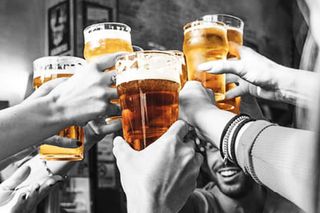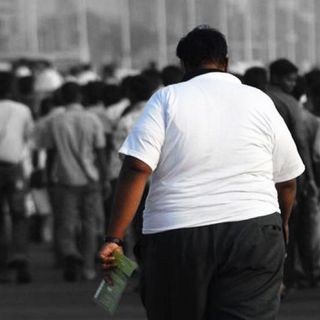
Alcohol Abuse Is a Spectrum; From Social Drinking to High‑Functioning Alcoholism
“If alcohol were a person, it would be one of my best friends.”

Society holds a narrow, stigmatized view of alcoholism, aided by exaggerated portrayals of addicts in popular culture — they slur their words, stumble around, wreck their professional and romantic lives, and are not dependable. While late stages of alcohol addiction can take this shape, alcohol abuse exists on a spectrum. While most of the symptoms of alcohol addiction escape stigma, it is still what constitutes an unhealthy reliance on the excessive consumption of alcohol.
A growing acceptance of drinking has normalized this abuse — since 2000, alcohol consumption has increased globally, according to the World Health Organization. In the South-East Asia region, current drinkers consume an average of 26.3 grams of alcohol per day (equivalent to three to five drinks depending on size), while balancing their lives and relationships effectively. Is this high-functionalism in tandem with regular alcohol abuse emotionally or physically unhealthy, or is it actually functional and not a big deal?
Sam* (not his real name), 24, started drinking when he was 13. What started as curiosity and rebellion as a teenager, quickly escalated to a point where he could out-drink the people around him and still act relatively sober. For the first three years of college — away from home, and funded by his parents — he stuck to drinking, albeit heavily, only on the weekends.
Related on The Swaddle:
The Truth About Alcohol and Cancer
“There has rarely been a time when I was sitting to drink, and I was drinking less than two [drinks]. That was impossible,” he said. All the while, Sam excelled at his classes and maintained a student job. After handling binge-drinking habits in tandem with his responsibilities, Sam went through a painful break-up, which sent him spiraling into clinical depression. He had anxiety attacks and suffered insomnia. He started drinking more, partly to numb the sadness, and partly to curb his increasingly strong feelings of inadequacy, he said. “When I drank, I started to be brave again. I would get motivated to do things. The next day, I was sober again, and the confidence would be gone,” said Sam. From only drinking on weekends, Sam began to drink on weekdays; from only drinking in the evening and night, Sam began to drink in the afternoon, and then in the morning. He failed all of his subjects for one year of college, during which time he was consuming more than one liter of alcohol per day.
“That was US$30,000 to US$35,000 down the drain. I used to lie at home. I was shit scared. My parents had trusted me. There is a big guilt factor. Every day I thought, ‘Tomorrow I’ll get better; I’ll get up on my feet.’ But tomorrow never comes,” he said. Only when Sam started realizing the health consequences of his alcohol abuse — a test revealed high amounts of toxicity in his liver, which can be fatal — he decided to move back home and start therapy to deal with his mental health issues and to be able to manage his alcohol habits.
Sam’s relationship with alcohol fits several criteria set by the Center for Disease Control; the agency says, “About 90% of people who drink excessively would not be expected to meet the clinical diagnostic criteria for having a severe alcohol use disorder.” The CDC defines moderate drinking, on one end of the alcohol abuse spectrum, as “having up to one drink per day for women and up to two drinks per day for men.” Any more, and alcohol consumption falls under “excessive alcohol use,” which includes heavy drinking (consuming 15 drinks or more per week for men, and eight or more for women) and binge drinking (consuming five or more drinks on a single occasion for men, and four or more on a single occasion for women). On the far end of the spectrum is alcohol use disorder, or alcoholism, which is characterized by an “inability to limit drinking, continuing to drink despite personal or professional problems, needing to drink more to get the same effect, and wanting a drink so badly you can’t think of anything else,” according to the CDC.
Heavy and binge drinking peaks between the ages of 20 to 24, with young people engaging more frequently than recommended, according to a study by the World Health Organization. Drinking has been on the rise in India in the past decade, with the country’s per capita consumption doubling from 2.4 liters to 5.7 liters between 2005 and 2016, according to a study by WHO. Alcohol consumption for men increased from 7.1 to 9.4 liters, while for women it increased from 1.3 to 1.7 liters. But those are likely underestimates; in South-East Asia, which includes India, “unrecorded alcohol consumption makes up some 50% or more of total alcohol consumption,” the WHO reports. The agency attributes the rise to a lack of policies to curb alcohol abuse. For instance, India has no national age limit to who can purchase alcohol; states irregularly enforce age limits that range from 21 to 25.
By 2025, India’s consumption of alcohol is expected to grow by 2.2 liters a year more, which the WHO said will be one of the highest increases in the South East Asia region. “Higher disposable incomes, change in attitudes towards alcohol consumption, and the proliferation of an eating-out culture” help the trend along, Quartz reported. In viewing alcohol habits as binary — either in control, or falling-down alcoholic — the country ignores a large population that might be effectively propping up the alcohol industry now, but are not the target demographic for health campaigns trying to curb the effects of alcohol abuse.
Even Sam’s early alcohol consumption, while still beyond recommended limits, would not have been a red flag for anybody paying attention. He successfully juggled his school and work responsibilities; successfully weaving in high-functionalism with excessive alcohol abuse. The American Addiction Centers defines high-functioning alcohol abuse as “dependence on, tolerance to, and intense cravings for alcohol,” but still able to maintain, or even excel at “a job, complete school, and have apparently healthy relationships.” This so-called high-functionalism often prevents individuals from checking their alcohol consumption or admitting its harmful effects; the detriment to day-to-day life might not manifest, but in the long term, consuming alcohol in amounts that surpass recommended limits can lead to severe health ailments, the agency adds.
According to The Recovery Village, a rehabilitation facility, high-functioning alcohol abuse can be spotted through subtle signs: Those engaging in excessive alcohol abuse “restrict their drinking to specific times, situations, or beverages… These self-imposed limitations might help the alcoholic convince himself that he is in control of his drinking when in fact, he often breaks his own rules.” They rely on friends and family to cover up the consequences of their alcohol abuse, either professional or financial. They also “isolate themselves in their private time,” while still acting sociable at work or at establishments where there are drinks involved; or, they may “break personal commitments because of their drinking.”
Most people who engage in excessive alcohol abuse also “secretly struggle with mental illness,” according to The Recovery Village, as many “high-functioning alcoholics use their substance abuse to mask psychological disorders like depression, social phobia, or an eating disorder. They may suffer from anxiety about their competency or material security. When they’re not under the influence, they may be moody, withdrawn, tearful, or irritable.”
“I think I fit into my own definition of what a high functioning alcoholic would be — the [alcoholic] part would be, of course, the consistency, the regularity, the frequency of alcohol consumption,” Laila* (not her real name), 25, said, adding she has at least 10 drinks in a week, which qualifies as heavy drinking under the CDC’s definitions. “The functioning part is getting back to reality very quickly the next day. … Of course, I’ll have a headache, or not be as emotionally available as I usually am, but at the same time, this thing happens that I will obviously go to work, and I will overcompensate so I work more; I end up working a lot more than I usually do. Because I feel that I might not be able to perform and function, so I function more.”
As for the effects of alcohol abuse, “genetic, psychological, social and environmental factors can impact how drinking alcohol affects your body and behavior,” according to the Mayo Clinic. “Over time, drinking too much alcohol may change the normal function of the areas of your brain associated with the experience of pleasure, judgment and the ability to exercise control over your behavior. This may result in craving alcohol to try to restore good feelings or reduce negative ones.”
For Laila, her alcohol consumption spikes when she’s alone. “My dependence on alcohol is directly proportional to alone time. I don’t like being alone, so if I have more people in my life, then I won’t resort to alcohol a lot,” she said. “I don’t like to be left with my thoughts alone. I’m somebody who takes herself very seriously. I’m not an expressive person. With alcohol, it’s just easier for me to distract myself from things that I think about, or express [them].”
In Sam’s case, his high-functioning alcohol abuse escalated in later years, due to mental health issues, which slowly deteriorated his ability to juggle alcohol dependency and his responsibilities. The American Addiction Centers lays out signs of exacerbated abuse: Those who slip into more frequent heavy and binge drinking have “difficulty controlling how much alcohol is consumed at one time, even when they say they will stop drinking; they begin to obsess about the next drink, outing to the bar, social event with alcohol, or dinner with wine or beer; they act drastically different when they are drunk compared to when they are sober; they experience blackouts regularly; they tell friends and family that they use alcohol as a reward or to relieve stress after work; they say they have no interest in eating, or they choose to drink instead of eating meals; and they hide bottles of alcohol, or they are dishonest about how much they consume because they do not want others to know about how much they drink.”
Related on The Swaddle:
Even Moderate Drinking Affects Longevity
While Sam existed on one side of the spectrum of problem drinking, Austin Williams, 37, hangs out on the other side. None of the above signs of excessive alcohol abuse apply, Williams said, even though his alcohol consumption flirts with going beyond recommended limits. He drinks once or twice a week, and it usually takes him four to six drinks to feel buzzed during a drinking session. After nights of heavy or binge drinking, he has, in the past, taken temporary respite from alcohol use.
Williams doesn’t need alcohol to function, sleep or enjoy himself. Alcohol hasn’t affected his professional or personal life; neither has it affected his health. Yet, alcohol, for him, is “a wingman, a coach and someone who brings out the best in me and, yes, also the worst. But I’ve also come to appreciate my worst qualities. It’s a great companion if I’m too nervous, apprehensive, or stressed to otherwise be my regular hyperactive, carefree, and joyful self. If alcohol were a person, it would be one of my best friends,” he said. In his mid-to-late 20s, Williams was worried about his increasing alcohol consumption, but, he said, “I was able to feel out my limits, get a sense of what drinks I liked and didn’t, how much was too much, how much was too little, and for what occasions too much was just right.” He considers alcohol not detrimental to his physical health, but instead as liberating to his mental health.
“Sometimes I want to drink enough to just sort of unbind any tensions in my shoulders or hesitance about meeting new people or being able to joke and have a good time. Other times, I go out with the specific intention to destroy myself — there’s something cathartic for me about drinking so much that it hurts,” Williams said. “There’s probably self-loathing issues in there, but also there’s usually some sort of beautiful afterglow involved too. I think I’ve somehow managed to condition myself to associate getting unhealthily drunk with good times to such an extent that even gnarly hangovers will make me laugh and smile.
“I’ve stayed pretty healthy since I’ve been consuming alcohol, even in large quantities. If it does start to affect my health, I don’t doubt that I’ll be able to make changes in my lifestyle to address the issues, even if that means abstaining completely,” Williams said.
Alcohol abuse and its symptoms (or lack thereof) vary depending on individuals’ inclinations, environments, and their health. This means the kind of help a person may need varies, too — from rehabilitation to cutting down on drinking, to just plain old self-awareness.
Sam, after moving back home, abstained from consuming alcohol for six months. With liver toxicity levels back within limits, he says he enjoys drinking, but no longer depends on it to get through the day.
“I used it for fun, then I used it to numb myself, to sleep, to shut the pain behind a back door for a while. Now, I use it again for fun,” he said. “The graph goes down from here; my consumption will only decrease. The day I get tipsy in five to six drinks, I’d be very happy.
“I’m going to take care of myself — but I’m not going to become a monk.”
Rajvi Desai is The Swaddle's Culture Editor. After graduating from NYU as a Journalism and Politics major, she covered breaking news and politics in New York City, and dabbled in design and entertainment journalism. Back in the homeland, she's interested in tackling beauty, sports, politics and human rights in her gender-focused writing, while also co-managing The Swaddle Team's podcast, Respectfully Disagree.
Related


How Much Water Should You Drink in a Day, Really?
